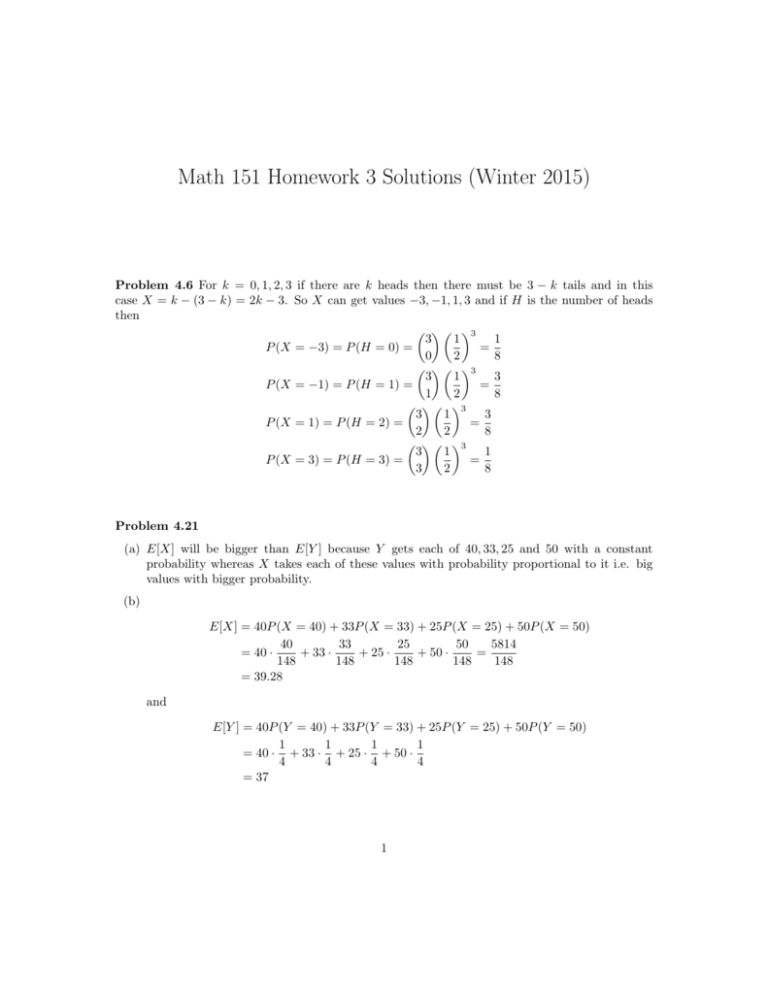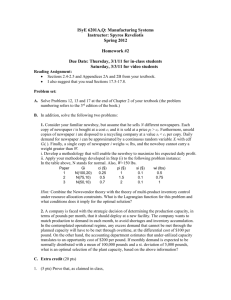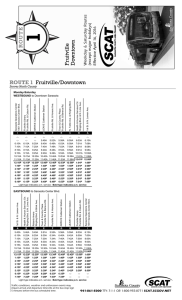Math 151 Homework 3 Solutions (Winter 2015)
advertisement

Math 151 Homework 3 Solutions (Winter 2015)
Problem 4.6 For k = 0, 1, 2, 3 if there are k heads then there must be 3 − k tails and in this
case X = k − (3 − k) = 2k − 3. So X can get values −3, −1, 1, 3 and if H is the number of heads
then
3
1
3
1
P (X = −3) = P (H = 0) =
=
0
2
8
3
3
3
1
=
P (X = −1) = P (H = 1) =
2
8
1
3
3
1
3
P (X = 1) = P (H = 2) =
=
2
2
8
3
3
1
1
P (X = 3) = P (H = 3) =
=
3
2
8
Problem 4.21
(a) E[X] will be bigger than E[Y ] because Y gets each of 40, 33, 25 and 50 with a constant
probability whereas X takes each of these values with probability proportional to it i.e. big
values with bigger probability.
(b)
E[X] = 40P (X = 40) + 33P (X = 33) + 25P (X = 25) + 50P (X = 50)
40
33
25
50
5814
= 40 ·
+ 33 ·
+ 25 ·
+ 50 ·
=
148
148
148
148
148
= 39.28
and
E[Y ] = 40P (Y = 40) + 33P (Y = 33) + 25P (Y = 25) + 50P (Y = 50)
1
1
1
1
= 40 · + 33 · + 25 · + 50 ·
4
4
4
4
= 37
1
Problem 4.26
(a) Observe that to guess the values i we need to ask exactly i questions. So X = i with
1
for all 1 ≤ i ≤ 10. So
probability
10
E[X] =
10
X
iP (X = i) =
i=1
10
X
i·
i=1
11
1
=
10
2
(b) Suppose we have the following strategy: if there are n remaining numbers a1 , . . . , an we ask ”Is
it in the set {a1 , . . . , abn/2c }?”. For example, to find 1 first ask ”Is it in the set {1, 2, 3, 4, 5}?”
and get answer ”Yes”. Then ask ”Is it in the set {1, 2}?” and get answer ”Yes”. Finally ask
”Is it in the set {1}?” and get answer ”Yes”. So in this case X = 3. Similarly to find 9 we
can ask ”Is it in the set {1, 2, 3, 4, 5}?” get ”No”; ask ”Is it in the set {6, 7}?” get ”No”; ask
”Is it in the set {8}?” get ”No”; ask ”Is it in the set {9}?” and get ”Yes”. So in this case
X = 4. With this strategy one needs 3 questions to find 1, 2, 3, 6, 7, 8 and 4 questions to find
4, 5, 9, 10. Thus
E[X] = 3P (X = 3) + 4P (X = 4) = 3 ·
4
17
6
+4·
=
10
10
5
Problem 4.33
Suppose newsboy purchases m paper. Since the demand is binomial with n = 10 obviously profit
will be maximized for some m ≤ 10. Let P be his profit and D be the demand in a day. Note that
he pays total 10m cents for m purchased newspapers and sells min{D, m} of them. So
E[P ] =
10
X
15 min{k, m}P (D = k) − 10m = 15
k=0
m−1
X
kP (D = k) + 15m
k=0
10
X
P (D = k) − 10m
k=m
Let f (m) be right hand side of above equation. Then
f (m + 1) − f (m) = 15
m
X
kP (D = k) − 15
kP (D = k)
k=0
k=0
+ 15(m + 1)
10
X
P (D = k) − 15m
k=m+1
10
X
= 15
m−1
X
10
X
P (D = k) − 10 = 15 1 −
k=m+1
m
X
= 5 − 15
P (D = k) − 10
k=m
m
X
!
P (D = k)
k=0
P (D = k) .
k=0
So we just need to find the maximum value of m such that
m
m k 10−k
X
X
10
1
2
1
FD (m) =
P (D = k) =
≤
k
3
3
3
k=0
k=0
2
− 10
Observe that
FD (2) =
1
23 × 28
<
39
3
FD (3) =
1
43 × 28
>
9
3
3
but
1
1
for all m ≤ 2 and FD (m) >
3
3
for all m ≥ 3. Hence f (m + 1) − f (m) > 0 for all m = 0, 1, 2 and f (m + 1) − f (m) < 0 for all
m = 3, . . . , 9. This means f gets its maximum when m = 3 i.e., newsboy needs to buy 3 newspapers
to maximize his profit.
Since FD is an increasing function we conclude that FD (m) <
Problem 4.42
(a) Let Xi = 1 if A answers i’th question correctly and Xi = 0 otherwise. Let Yi = 1 if B
10
X
Xi Yi is the total number
answers i’th question correctly and Yi = 0 otherwise. Then Z =
i=1
of questions answered by both of A and B. Hence
E[Z] =
10
X
E[Xi Yi ] =
i=1
10
X
E[Xi ]E[Yi ] =
i=1
10
X
0.7 · 0.4 = 2.8
i=1
(b) Now let Xi0 = 1 if A’s answer for i’th question is wrong and Xi0 = 0 otherwise. Similarly, let
10
X
(1−Xi Yi ) =
Yi = 1 if B’s answer for i’th question is wrong and Yi = 0 otherwise. Then Z =
i=1
10 −
10
X
Xi Yi is the total number of questions answered by at least one of A and B. Hence
i=1
Var(Z) = Var
10
X
i=1
!
Xi Yi
=
10
X
Var(Xi Yi ) =
i=1
10
X
03 · 0.6 − (03 · 0.6)2 = 1.476
i=1
Problem 4.78
For 1 ≤ i ≤ n let Xi be the eventthat
selection does not have exactly 2
the outcome of the i’th 4 4
T
17
n−1
c
white balls. Then P (Xi ) = 1 − 2 82 =
and A =
i=1 Xi ∩ Xn is the event that we shall
35
4
make exactly n selections. Then
P (A) = P (Xnc )
n−1
Y
P (Xi ) =
i=1
3
18
35
17
35
n−1
Problem 4.T.13
We want to maximize f (p) = P (X = k) =
n k
p (1 − p)n−k for 0 ≤ p ≤ 1. Since
k
n
kpk−1 (1 − p)n−k − pk (n − k)(1 − p)n−k−1
f (p) =
k
n k−1
=
p
(1 − p)n−k−1 (k(1 − p) − (n − k)p)
k
n k−1
=
p
(1 − p)n−k−1 (k − np)
k
0
f is increasing for p <
k
k
k
and decreasing for p > . So f (p) maximizes when p = .
n
n
n
Note: Another interesting question would be to find k which maximizes P (X = k) for a fixed n and
k
n k
p
n−k
n n
p. To find such k write P (X = k) =
p (1 − p)
= (1 − p)
. So it is enough
1−p
k
k
k
p
n
. Observe that
to maximize g(k) =
1−p
k
k+1 k n
p
p
p
n−k
n−k
n
p
=
·
= g(k)
·
g(k + 1) =
k
1−p
1−p
1−p k+1
1−p k+1
k+1
So
p
n−k
·
≥ 1 ⇐⇒ (n + 1)p − 1 ≥ k
1−p k+1
So g(k) achieves its maximum when k = b(n + 1)pc.
g(k + 1) ≥ g(k) ⇐⇒
Problem 4.T.16
Observe that
λi
λi−1
λ
λ
= e−λ
· = P (X = i − 1) ·
i!
(i − 1)! i
i
So P (X = i) is increasing for i ≤ λ and decreasing for i ≥ λ. So it gets maximum when i = bλc.
P (X = i) = e−λ
Problem 4.T.21
(a) Let Ai be the event that persons 3 and 4 have birthdays on day i and let Bj be the event
that persons 1 and 2 have birthdays on day j. Then
365 X
365
X
P (E3,4 |E1,2 ) =
P (E3,4 E1,2 )
=
P (E1,2 )
i=1 j=1
365
X
j=1
4
365 X
365
X
P (Ai Bj )
P (Bj )
=
i=1 j=1
365
X
j=1
1
3654
1
3652
=
1
365
(b) Let Ck be the event that persons 1, 2 and 3 have birthdays on day k. Then
365
X
P (E1,3 |E1,2 ) =
P (E1,3 E1,2 )
= k=1
365
P (E1,2 )
X
j=1
365
X
P (Ck )
=
P (Bj )
k=1
365
X
j=1
1
3653
=
1
3652
1
365
(b)
365
X
P (E2,3 E1,2 E1,3 )
= k=1
P (E2,3 |E1,2 E1,3 ) =
365
P (E1,2 E1,3 )
X
P (Ck )
=1
P (Ck )
k=1
This shows that events Eij are pairwise independent but not mutually independent.
5
Problem 4.T.27
Since
P (X > n) =
∞
X
P (X = n + k) =
k=1
∞
X
p(1 − p)n+k−1 = p(1 − p)n
k=1
∞
X
(1 − p)k−1 = (1 − p)n
k=1
we get
P (X = n+k|X > n) =
P (X = n + k)
p(1 − p)n+k−1
P ({X = n + k}{X > n})
= p(1−p)k−1 = P (X = k)
=
=
P (X > n)
P (X > n)
(1 − p)n
This is because failing in the first n trials does not give any information about the future. In
particular, after n fails the process of waiting for the first success will be as if you just started the
game and waiting for the first success.
6











